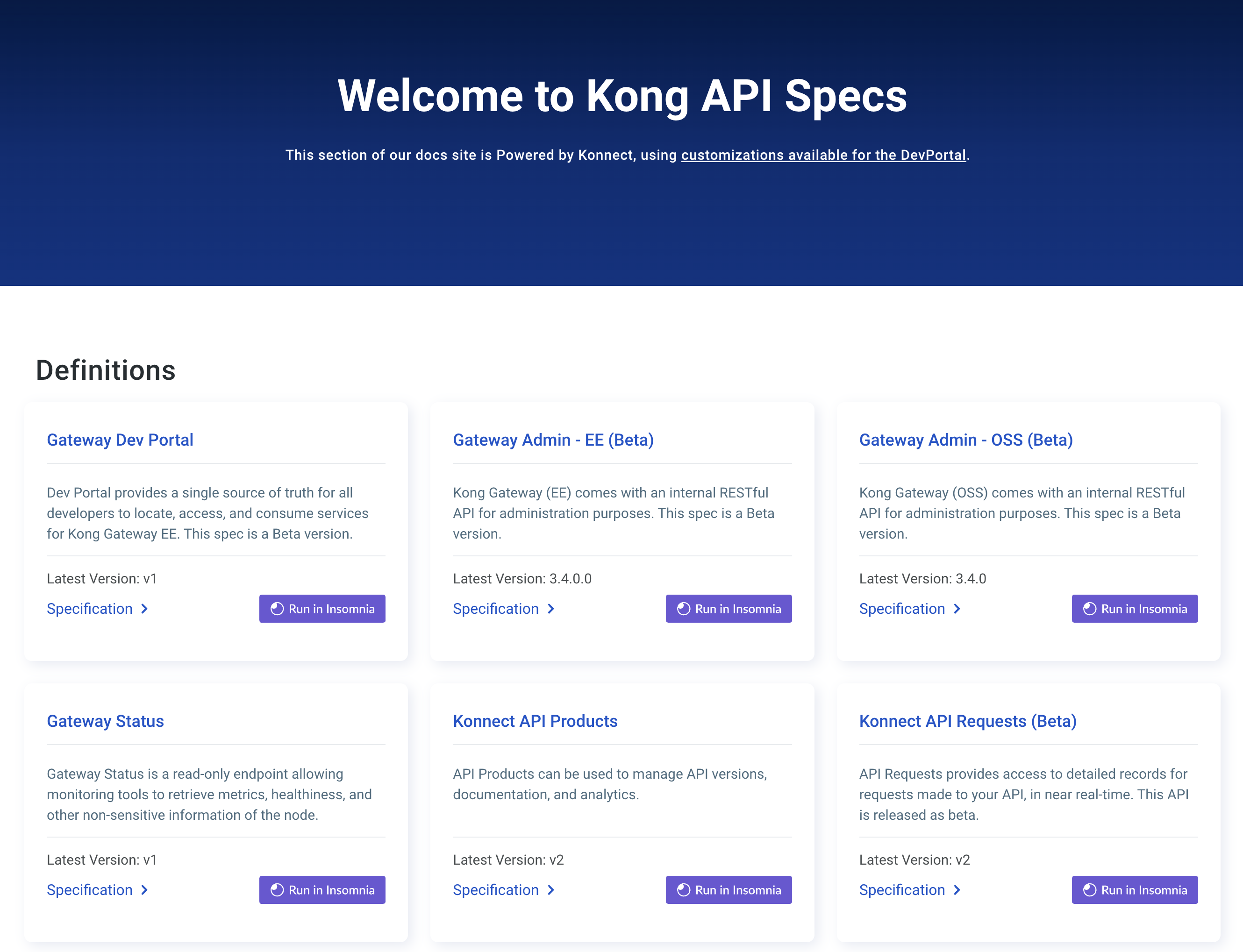このページは、まだ日本語ではご利用いただけません。翻訳中です。
Upstream and Target
In this guide you’ll learn how to use the KongUpstream and KongTarget custom resources to
manage Kong Konnect upstreams
and their targets natively from your Kubernetes cluster.
Prerequisites: Install Kong Gateway Operator and create a valid KonnectAPIAuthConfiguration and KonnectGatewayControlPlane in your cluster.
Install Kong Gateway Operator and create a valid KonnectAPIAuthConfiguration and KonnectGatewayControlPlane in your cluster.
Install Kong Gateway Operator
Update the Helm repository:
helm repo add kong https://charts.konghq.com
helm repo update kong
Install Kong Gateway Operator with Helm:
helm upgrade --install kgo kong/gateway-operator -n kong-system --create-namespace \
--set image.tag=1.6 \
--set kubernetes-configuration-crds.enabled=true \
--set env.ENABLE_CONTROLLER_KONNECT=true
You can wait for the operator to be ready using kubectl wait:
kubectl -n kong-system wait --for=condition=Available=true --timeout=120s deployment/kgo-gateway-operator-controller-manager
Create an access token in Konnect
You may create either a Personal Access Token (PAT) or a Service Account Token (SAT) in Konnect. Please refer to the
Konnect authentication documentation for more information. You will need this token
to create a KonnectAPIAuthConfiguration object that will be used by the Kong Gateway Operator to authenticate
with Konnect APIs.
Create a Kong Konnect API auth configuration
Depending on your preferences, you can create a KonnectAPIAuthConfiguration object with the token specified
directly in its spec or as a reference to a Kubernetes Secret. The serverURL field should be set to the Konnect API
URL in a region where your Kong Konnect account is located. Please refer to the list of available API URLs
for more information.
You can verify the KonnectAPIAuthConfiguration object was reconciled successfully by checking its status.
kubectl get konnectapiauthconfiguration konnect-api-auth
The output should look like this:
NAME VALID ORGID SERVERURL
konnect-api-auth True <your-konnect-org-id> https://us.api.konghq.com
Create a Kong Gateway control plane
Creating the KonnectGatewayControlPlane object in your Kubernetes cluster will provision a Kong Konnect Gateway
control plane in your Gateway Manager. The KonnectGatewayControlPlane CR
API allows you to
explicitly set a type of the Kong Gateway control plane, but if you don’t specify it, the default type is
a Self-Managed Hybrid
gateway control plane.
You can create one by applying the following YAML manifest:
echo '
kind: KonnectGatewayControlPlane
apiVersion: konnect.konghq.com/v1alpha1
metadata:
name: gateway-control-plane
namespace: default
spec:
name: gateway-control-plane # Name used to identify the Gateway Control Plane in Konnect
konnect:
authRef:
name: konnect-api-auth # Reference to the KonnectAPIAuthConfiguration object
' | kubectl apply -f -
You can see the status of the Gateway Control Plane by running:
kubectl get konnectgatewaycontrolplanes.konnect.konghq.com gateway-control-plane
If the Gateway Control Plane is successfully created, you should see the following output:
NAME PROGRAMMED ID ORGID
gateway-control-plane True <konnect-control-plane-id> <your-konnect-ord-id>
Having that in place, you will be able to reference the gateway-control-plane in your Kong Konnect entities as their parent.
Create an upstream
Creating the KongUpstream object in your Kubernetes cluster will provision a Kong Konnect key in
your Gateway Manager.
You can refer to the CR API
to see all the available fields.
Your KongUpstream must be associated with a KonnectGatewayControlPlane object that you’ve created in your cluster.
It will make it part of the Gateway Control Plane’s configuration.
To create a KongUpstream, you can apply the following YAML manifest:
echo '
kind: KongUpstream
apiVersion: configuration.konghq.com/v1alpha1
metadata:
name: upstream
namespace: default
spec:
name: upstream
controlPlaneRef:
type: konnectNamespacedRef # This indicates that an in cluster reference is used
konnectNamespacedRef:
name: gateway-control-plane # KonnectGatewayControlPlane reference
' | kubectl apply -f -
You can verify the KongUpstream was reconciled successfully by checking its Programmed condition.
kubectl get kongupstream upstream -o=jsonpath='{.status.conditions[?(@.type=="Programmed")]}' | jq
The output should look similar to this:
{
"observedGeneration": 1,
"reason": "Programmed",
"status": "True",
"type": "Programmed"
}
At this point, you should see the Upstream in the Gateway Manager UI.
Create a target
Each KongTarget must be associated with a KongUpstream it’s meant to be a backend for. For this reason, you must
specify the upstreamRef field in the spec section of the KongTarget object. Please refer to the CR API
to see all the available fields.
To create two different KongTargets associated with the KongUpstream created before, you can apply the following
YAML manifest:
echo '
kind: KongTarget
apiVersion: configuration.konghq.com/v1alpha1
metadata:
name: target-a
namespace: default
spec:
upstreamRef:
name: upstream # Reference to the KongUpstream object
target: "10.0.0.1"
weight: 30
---
kind: KongTarget
apiVersion: configuration.konghq.com/v1alpha1
metadata:
name: target-b
namespace: default
spec:
upstreamRef:
name: upstream # Reference to the KongUpstream object
target: "10.0.0.2"
weight: 70
' | kubectl apply -f -
You can verify both KongTargets successfully were associated with the KongUpstream by checking their
KongUpstreamRefValid condition.
kubectl get kongtarget target-a -o=jsonpath='{.status.conditions[?(@.type=="KongUpstreamRefValid")]}' | jq
The output should look similar to this:
{
"observedGeneration": 1,
"reason": "Valid",
"status": "True",
"type": "KongUpstreamRefValid"
}
kubectl get kongtarget target-b -o=jsonpath='{.status.conditions[?(@.type=="KongUpstreamRefValid")]}' | jq
The output should look similar to this:
{
"observedGeneration": 1,
"reason": "Valid",
"status": "True",
"type": "KongUpstreamRefValid"
}
You can also verify both KongTargets were reconciled successfully by checking their Programmed condition.
kubectl get kongtarget target-a -o=jsonpath='{.status.conditions[?(@.type=="Programmed")]}' | jq
The output should look similar to this:
{
"observedGeneration": 1,
"reason": "Programmed",
"status": "True",
"type": "Programmed"
}
kubectl get kongtarget target-b -o=jsonpath='{.status.conditions[?(@.type=="Programmed")]}' | jq
The output should look similar to this:
{
"observedGeneration": 1,
"reason": "Programmed",
"status": "True",
"type": "Programmed"
}
At this point, you should see both Targets in the upstream Upstream in the Gateway Manager UI.












